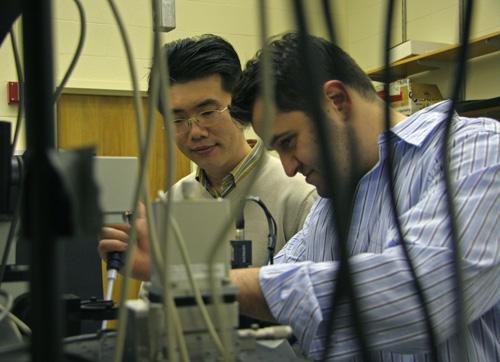UI studies yield findings for cell fusion research

Physics professor Taekjip Ha, left, and post doctoral student Burak Okumus demonstrate lab procedures while discussing their research that was recently published in Loomis Lab, Friday. Using ultra-sensitive single molecule microscopy they were able to wat ME Online
Feb 7, 2007
Last updated on May 12, 2016 at 07:43 a.m.
The flu virus enters the human body when fusion occurs between a cell membrane and the virus membrane. The fertilization of an egg is caused by two membranes fusing together. This is what the scientific community knew about the fusion between two membranes until researchers at the University discovered a way to break down the process and look at single vesicle fusion, something that has never been done before.
Taekjip Ha, professor of physics, along with Burak Okumus and Tae-Young Yoon, both graduate students, began working on the process of breaking down single vesicle fusion in July 2005. The findings were published and appeared on the cover of the Proceedings of the National Academy of Sciences in December 2006.
The study was collaborated with Iowa State University and funded by grants from the National Institute of General Medical Sciences.
Ha said neurons are firing and cells are fusing all the time in the body. It is difficult to discover why neurons fire at different times and don’t fire other times.
Get The Daily Illini in your inbox!
“Neurons are firing really quickly. When you write, talk, run, neurons are firing,” Ha said. “If you want to study how these things work very well, you need to know what is doing this fusion.”
Part of the reason why this is difficult is there must be full cells in order to truly see the living fusion.
“If you just have the membranes itself fusion doesn’t happen,” said Ha.
Other scientists had been able to study larger quantities of membranes fusing in laboratory beakers, but until now no one actually broke it down to see only one neuron membrane fusing with another.
“We are trying to understand the mechanisms of what is going on when they fuse,” Okumus said.
The researchers knew that the merging of two membranes was caused by membrane proteins called SNAREs so they divided two batches of SNAREs and added green dye to one batch and red dye to another to better tell the difference between the two membranes.
The fusion process only lasts about 5 seconds, but scientists can learn a lot about this fusion with the camera recording every move of the membranes.
The scientists know the fusion is over when all the SNAREs are one color.
The researchers concluded that there is a hemi-fusion that occurs first where the outer layer of the membrane combines, with the inner membrane following for full fusion.
“No one has shown this (hemi-fusion) in the singular vesicle level.” said Ha. “We have done the measurement to show that this actually happens,”
Burak explained that this is a measure of transfer efficiency.
“You can plot out the energy transfer over time. What we saw is that it happened in steps,” he said. “(The) fusion pore might just act like a valve flickering and not letting everything go at once, which is why it may be in steps.”
Ha said the experiment was very basic in order to understand the simplest part of what was occurring, and scientists and researchers can now move on from there to see more complex things.
“If you know how the fusion is regulated you can design a strategy to interfere with the fusion,” Ha said. “Our studies could be used for a basis of future therapeutic applications.”





